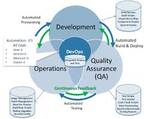
Limited Time Offer!
For Less Than the Cost of a Starbucks Coffee, Access All DevOpsSchool Videos on YouTube Unlimitedly.
Master DevOps, SRE, DevSecOps Skills!
Enroll Now
Source:-devops.com
In a rapidly growing global digital landscape, enterprises are facing many challenges. These include changing customer behavior and the need to be in line with the latest technology trends. To address these challenges and to stay up the competition curve, enterprises are adopting a slew of strategies. These comprise expanding the capacity of processes, quick quality checking and delivery of applications and timely marketing of the applications. This is where DevOps comes as a one-stop solution to the aforementioned requirements.
When it comes to assuring the quality of software applications, the Agile and DevOps model of testing is favored over the traditional waterfall model. This is because software applications need to be tested across a swathe of platforms—devices, browsers and operating systems. In the DevOps scheme of things, software builds are continuously integrated and deployed in the development pipeline by using test automation. It involves the development and implementation of new features along with the streamlining of processes.
What Is DevOps?
DevOps is an amalgamation of terms “development” and “operations” and is underpinned on four basic pillars—culture, tools, collaboration and practices. Combining processes and philosophies, the DevOps approach helps enterprises deliver quality builds in the SDLC. Here, development and operations teams no longer work in silos but in close coordination with each other. As a result, quality becomes a shared responsibility and a culture of accountability gains ground. DevOps implementation leads to the quick development and deployment of quality builds, faster solving of critical issues and engendering greater trust and confidence.
Let us understand the best DevOps implementation strategies to derive outcomes such as continuous integration (CI) and continuous delivery (CD). To begin with, getting the QA basics right the first time and every time should be considered as part of the strategy. This is due to the fact that in a pure DevOps ecosystem, the lines between development and QA are blurred.
Test Automation
Since the software needs to have an omnichannel interface with third-party applications to perform optimally, the test process should be automated. There should be a smooth QA-DevOps alignment to detect and mitigate glitches early on in the SDLC. Thus, DevOps testing may involve choosing automated tools that are either open-source or commercial.
Teams Merge
To derive DevOps transformation, the integration of the QA team with other technical specialists becomes important. The final DevOps team should adapt a culture wherein identifying glitches becomes a shared responsibility.
Metrics
Since DevOps testing is all about quick identification and fixing of glitches, the metrics should be defined at the beginning. It will help the DevOps team to stay focused on the challenges and requirements. This calls for the QA engineers to setup test requirements into the workflow and guide the team therein.
Virtualization
The software application should be tested across a slew of platforms—devices, browsers or operating systems. Since it is well-nigh impossible to test the codes for numerous users (during usability testing), the same ought to be created virtually. The QA team can virtualize every test requirement to emulate the behavior of software components. Moreover, it helps to do away with the need for dependencies and addresses constraints faced in interdependent environments.
Choose the Right Tools
To enable DevOps automation, the QA team should choose the right test automation tool. The main criteria for choosing the tool should be the team’s expertise in using it. The tool should offer the ease of writing the test script in a single programming language. It should allow the testing of applications across operating platforms and browsers.
Continuous Integration and Continuous Deployment
These are the outcomes of any DevOps methodology. DevOps continuous integration and deployment encompass adding code changes in a repository and creating automated builds. This leads to an early recovery from failures as well as testing and delivery of products within fast turnarounds. Continuous integration based on test automation leverages regression testing and a version control system when a new code is added. Further, DevOps continuous deployment is about the capability to add new features to the existing applications. This makes enterprises follow a user-driven improvement of software and agile approach.
Conclusion
With the quality of software applications becoming the final arbiter in making an enterprise successful, taking the DevOps approach is crucial. However, since the whole process is hinged on executing comprehensive quality testing, the QA basics should be done right.
